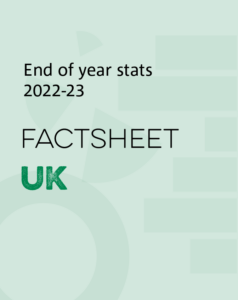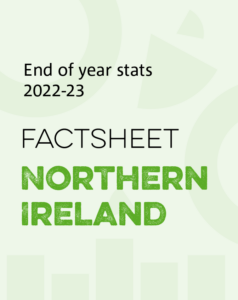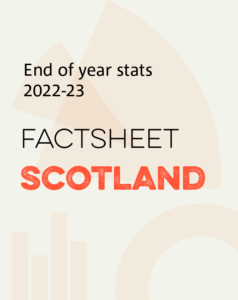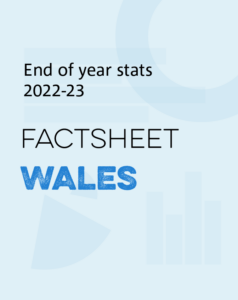End of Year Stats
Close to 3 million emergency food parcels were distributed by food banks in the Trussell Trust network in the past 12 months — the most parcels ever distributed by the network in a year.
Food banks in the Trussell Trust network saw the highest ever levels of need, even more than during the peak of the pandemic, as more people found their incomes did not cover the cost of essentials like heating and food. Between April 2022 and March 2023, the number of people that used a food bank for the first time was 760,000.
December 2022 was the busiest month on record for food banks in the Trussell Trust network, with a food parcel being distributed every 8 seconds.
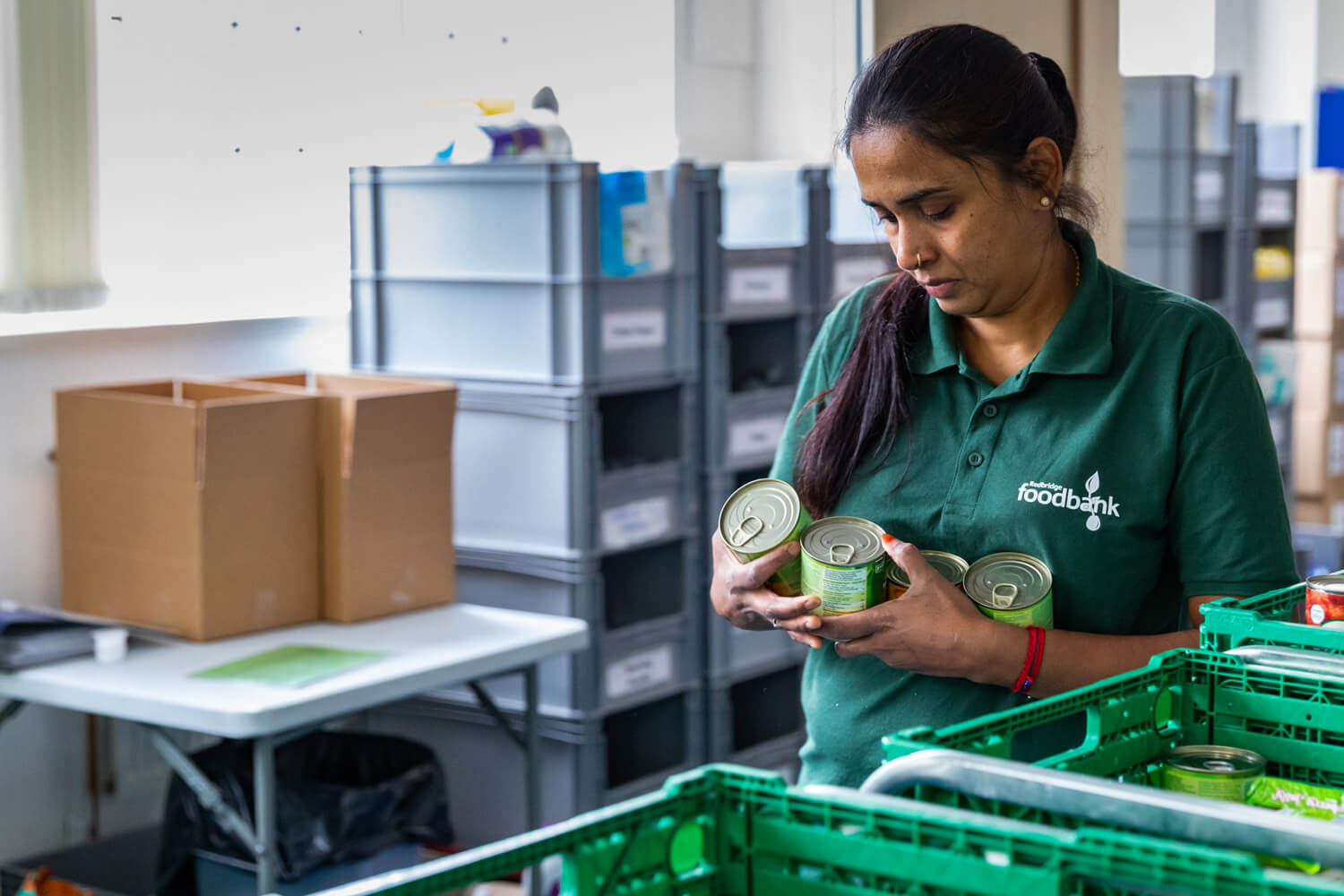

2,986,203
emergency food parcels

37%
increase from the same period in 2021/22

1 million
emergency food parcels provided for children
Between 1 April 2022 and 31 March 2023, food banks in the Trussell Trust’s UK wide network distributed close to 3 million emergency food parcels to people facing hardship – this is an increase of 37% from the same period last year. More than one million of these parcels were distributed for children.
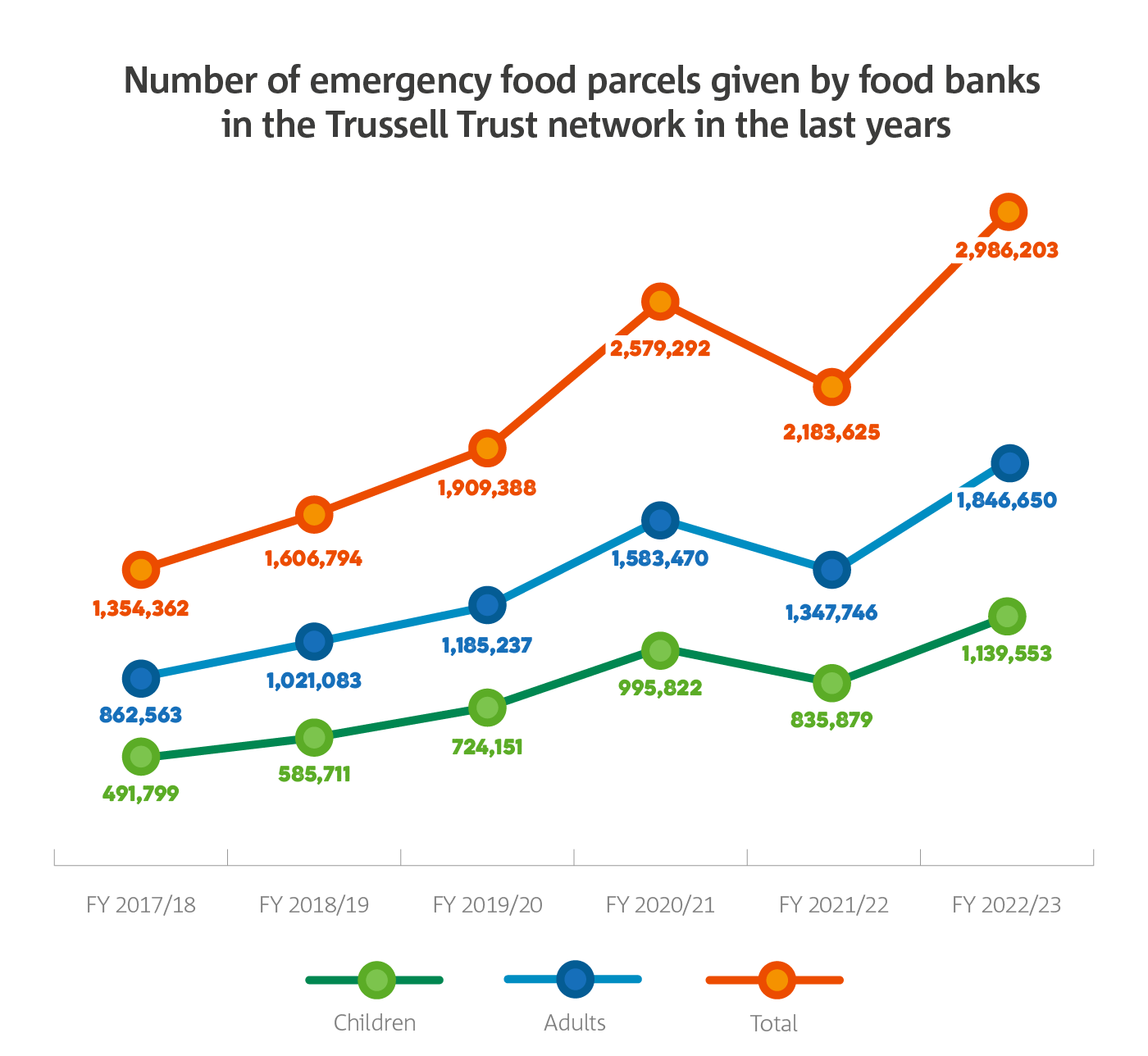
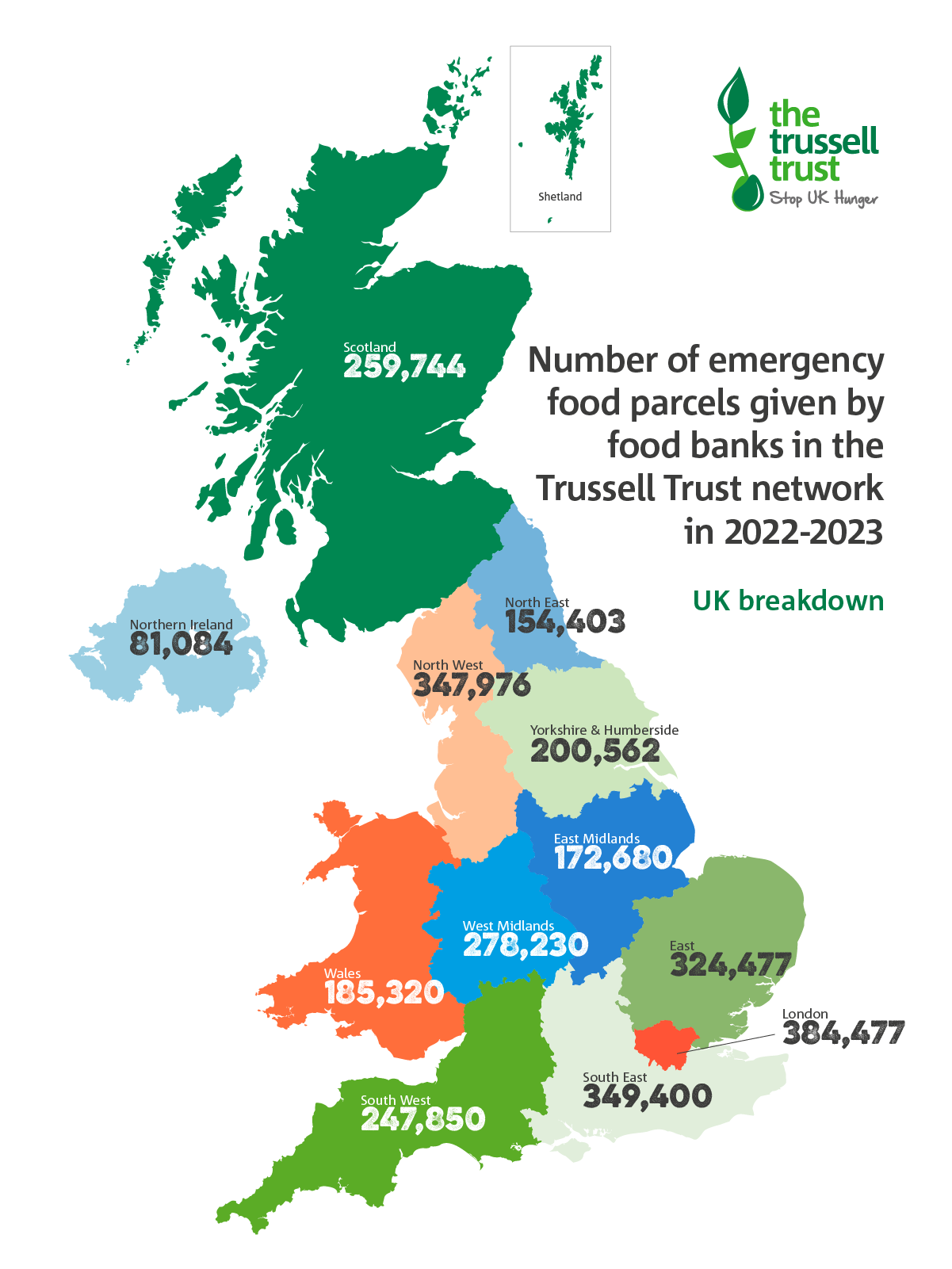
It’s time to guarantee our essentials
While the pandemic and cost of living crisis have had a major impact on food bank need, they are not the main cause. Rather, they have exposed and exacerbated a longer-term crisis: that of a weakened social security system that is unable to protect people from the most severe forms of hardship, thereby forcing more people to the doors of food banks.
Rising food bank need demonstrates more and more people are going without the essentials – we’re calling on the UK government to enshrine in law the amount needed to cover bills and essential items.
“These new statistics are extremely concerning and show that an increasing number of people are left with no option but to turn to charitable, volunteer-run organisations to get by and this is not right. The continued increase in parcel numbers over the last five years indicates that it is ongoing low levels of income and a social security system that isn’t fit for purpose that are forcing more people to access food banks, rather than just the recent cost of living crisis or the COVID-19 pandemic.
Food banks were set up to provide short-term support to people in an emergency, they are not a lasting solution to hunger and poverty, and more than three quarters of the UK population agree with us that they should not need to exist.
The staff and volunteers in our network are working tirelessly to ensure help continues to be available, but the current situation is not one they can solve alone.
For too long people have been going without because social security payments are not based on a real reflection of life’s costs and people are being pushed deeper into hardship as a result. If we are to stop this continued growth and end the need for food banks then the UK government must ensure that the standard allowance of Universal Credit is always enough to cover essential costs.”

Emma Revie
Chief Executive
Factsheets
Read our factsheets for a detailed breakdown of what this year’s statistics are telling us at a UK level and the findings for Northern Ireland, Scotland, and Wales.
Food bank Statistics for previous Financial Years with Regional Breakdown
| TOTAL | 2017/18 | 2018/19 | 2019/20 | 2020/21 | 2021/22 | 2022/23 |
| United Kingdom | 1,354,362 | 1,606,794 | 1,909,388 | 2,579,292 | 2,183,625 | 2,986,203 |
| England | 1,046,776 | 1,236,153 | 1,489,537 | 2,128,471 | 1,789,656 | 2,460,055 |
| Scotland | 173,531 | 217,055 | 238,597 | 224,624 | 199,676 | 259,744 |
| Wales | 100,362 | 116,325 | 136,115 | 146,757 | 131,663 | 185,320 |
| Northern Ireland | 33,693 | 37,261 | 45,139 | 79,440 | 62,630 | 81,084 |
| East Midlands | 67,078 | 78,229 | 101,788 | 138,775 | 128,754 | 172,680 |
| East of England | 127,027 | 152,678 | 190,145 | 245,331 | 224,413 | 324,477 |
| London | 137,248 | 167,726 | 204,362 | 423,294 | 284,687 | 384,477 |
| North East | 65,177 | 89,479 | 98,520 | 124,494 | 100,334 | 154,403 |
| North West | 198,825 | 225,198 | 254,221 | 313,817 | 253,084 | 347,976 |
| South East | 128,488 | 155,697 | 199,519 | 305,182 | 259,363 | 349,400 |
| South West | 122,383 | 133,983 | 163,244 | 202,350 | 174,950 | 247,850 |
| West Midlands | 121,048 | 142,917 | 169,143 | 226,512 | 207,863 | 278,230 |
| Yorkshire and The Humber | 79,502 | 90,246 | 108,595 | 148,716 | 156,208 | 200,562 |
| ADULTS | 2017/18 | 2018/19 | 2019/20 | 2020/21 | 2021/22 | 2022/23 |
| United Kingdom | 862,563 | 1,021,083 | 1,185,237 | 1,583,470 | 1,347,746 | 1,846,650 |
| England | 660,808 | 779,092 | 917,179 | 1,296,501 | 1,100,260 | 1,513,487 |
| Scotland | 117,545 | 145,607 | 157,545 | 146,621 | 128,699 | 171,776 |
| Wales | 64,341 | 74,480 | 84,353 | 92,216 | 83,005 | 115,637 |
| Northern Ireland | 19,869 | 21,904 | 26,160 | 48,132 | 35,782 | 45,750 |
| East Midlands | 42,436 | 48,956 | 62,503 | 84,700 | 81,696 | 107,516 |
| East of England | 78,717 | 93,669 | 113,858 | 142,980 | 132,107 | 192,995 |
| London | 88,534 | 107,537 | 129,417 | 263,663 | 178,128 | 238,902 |
| North East | 41,369 | 56,202 | 62,037 | 78,334 | 63,350 | 95,452 |
| North West | 123,574 | 141,217 | 153,835 | 193,024 | 155,372 | 213,707 |
| South East | 80,448 | 98,124 | 120,729 | 182,041 | 156,257 | 211,528 |
| South West | 77,109 | 84,197 | 100,398 | 122,645 | 107,476 | 153,629 |
| West Midlands | 77,415 | 91,680 | 106,888 | 138,135 | 130,554 | 174,338 |
| Yorkshire and The Humber | 51,206 | 57,510 | 67,514 | 90,979 | 95,320 | 125,420 |
| CHILDREN | 2017/18 | 2018/19 | 2019/20 | 2020/21 | 2021/22 | 2022/23 |
| UnitedKingdom | 491,799 | 585,711 | 724,151 | 995,822 | 835,879 | 1,139,553 |
| England | 385,968 | 457,061 | 572,358 | 831,970 | 689,396 | 946,568 |
| Scotland | 55,986 | 71,448 | 81,052 | 78,003 | 70,977 | 87,968 |
| Wales | 36,021 | 41,845 | 51,762 | 54,541 | 48,658 | 69,683 |
| Northern Ireland | 13,824 | 15,357 | 18,979 | 31,308 | 26,848 | 35,334 |
| East Midlands | 24,642 | 29,273 | 39,285 | 54,075 | 47,058 | 65,164 |
| East of England | 48,310 | 59,009 | 76,287 | 102,351 | 92,306 | 131,482 |
| London | 48,714 | 60,189 | 74,945 | 159,631 | 106,559 | 145,575 |
| North East | 23,808 | 33,277 | 36,483 | 46,160 | 36,984 | 58,951 |
| North West | 75,251 | 83,981 | 100,386 | 120,793 | 97,712 | 134,269 |
| South East | 48,040 | 57,573 | 78,790 | 123,141 | 103,106 | 137,872 |
| South West | 45,274 | 49,786 | 62,846 | 79,705 | 67,474 | 94,221 |
| West Midlands | 43,633 | 51,237 | 62,255 | 88,377 | 77,309 | 103,892 |
| Yorkshire and The Humber | 28,296 | 32,736 | 41,081 | 57,737 | 60,888 | 75,142 |
What do these stats show?
Every year we release statistics about the number of emergency food parcels food banks in our network have provided to people. We release figures for the first six months of the financial year in November, and for the full financial year at the end of April. These figures cover 1 April 2022 to 31 March 2023.
Our statistics are a measure of volume rather than unique users. The data is collected using an online system into which food banks enter data from each food bank voucher, and the number of emergency food supplies is recorded.
For example, if a family of three were referred to a food bank twice in one year, this would count as six supplies on the system because it would reflect six instances of a supply going to someone in the household. However, if a family of three were only referred to a food bank once, this would count as three supplies.
Figures from the Trussell Trust cannot be used to full explain the scale of food bank use across the UK, because our figures relate to food banks in our network and not to the hundreds of independent food aid providers and community groups also providing emergency food, which have increased in number through the pandemic. There are more than 1300 food bank centres in the Trussell Trust’s UK-wide network. The Independent Food Aid Network has identified at least 1,172 independent food banks, while there are also Salvation Army food banks as well as food banks run from schools and hospitals. There are also thousands of food of other food aid providers including soup kitchens and social supermarkets.
You can read more about our methodology here. Download the Raw Data file here.
To find out more about the drivers of hunger and who is most at risk, read our research on Hunger in the UK.
